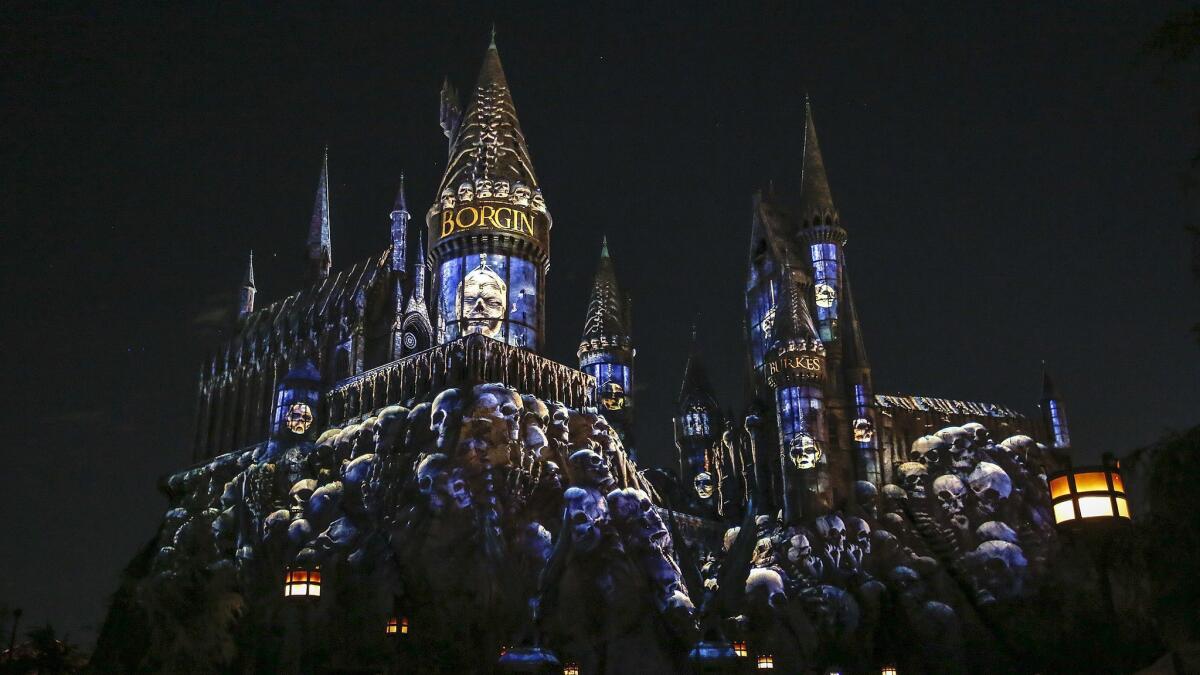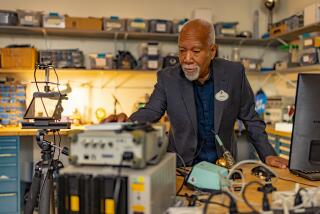At Universal, Harry Potter can vanquish Voldemort — but not high winds

The new “Dark Arts at Hogwarts” light show opens to the public Saturday. It features fire, fog, projection mapping and drone effects. (Robert Gauthier / Los Angeles Times)
Harry Potter’s magic is powerful enough to overcome black-hooded Death Eaters, soul-sucking Dementors and the like, although even the boy wizard has trouble operating in foul weather.
Universal Studios Hollywood debuted a nighttime light show this week that features cutting-edge projection technology, fire and fog to depict a battle between Potter and the followers of the evil Lord Voldemort, played out across the surface of the park’s 200-foot-tall Hogwarts Castle.
But one of the most anticipated elements of the show — hundreds of light-bearing drones programmed to create a 3-D image in the sky — was canceled because of strong winds during a preview Thursday night.
“One thing we don’t control is the environment, so wind and rain and other things are factors that can affect these special effects,” said Anil V. Nanduri, drone group general manager at Intel Corp., the company that operates the drones for the light show. “There are limits where the technology works.”
“The Dark Arts at Hogwarts” light show is the latest example of how theme parks that once relied almost exclusively on actors, dancers and singers to entertain parkgoers are turning more heavily to powerful technology such as projection mapping and computer-piloted drones.

Universal’s new show opens to the public Saturday and runs nightly through April 28. It will return for the weekend of May 25 through May 27.
The light show relies on special software to operate high-powered projectors that cast moving images onto the surface of buildings and attractions to create 3-D illusions on the uneven surfaces.
Disneyland in Anaheim used the same technology to light up Main Street during its 60th anniversary celebration in 2015. Universal Studios Hollywood has been using the technology for light shows since the Wizarding World of Harry Potter expansion opened in April 2016.
In Universal Studios Hollywood’s “Dark Arts” show, the projectors create giant spiders, flaming dragons, skulls and trolls that grow and creep along the surface of the castle. The show depicts the building being overrun by Potter’s tormentors, who nearly destroy the famous wizarding school, until Potter casts a spell that unleashes his Patronus — a glowing stag — that fends off his nemesis.
The show is expected to climax with hundreds of lighted drones taking the shape of the Patronus in the night sky next to the castle.
But winds of up to 25 mph forced the drones to stay grounded Thursday night. Park officials said the light show will continue without the drones whenever strong winds, rain and other foul weather threaten.

Intel’s drone technology has been used in night aerial shows during the most recent Super Bowl, last year’s Coachella Valley Music and Arts Festival and during the closing ceremonies of the last winter Olympics. Walt Disney World in Orlando, Fla., used 300 drones for a Christmas light show in 2016.
Universal Studios Hollywood representatives say the new show may be the first time a theme park has combined drones with projection mapping in a nightly show.
Dennis Speigel, president of International Theme Park Services, called the use of drones at theme parks “the wave of the future.”
He noted that both Universal Studios and the Walt Disney Co. have submitted applications to the U.S. Patents and Trademark Office to use drones in their theme parks, primarily for entertainment purposes. Speigel said he suspects theme parks may have plans to monitor guests by drone.
“You can literally put hundreds of them in the sky,” he said.
Universal Studios officials have declined to give out details on the drones, refusing to say how many are used in the Hogwarts show and from where they are launched.
“What we can say is that this is highly orchestrated and choreographed use of technology that our guests haven’t seen before,” said Stephen Siercks, senior director of entertainment at the theme park.
Nanduri said such drone shows are usually operated by a master computer that launches and directs hundreds or even thousands of drones at the same time. The program that controls the drones can be quickly rewritten to create a new show for a new event or holiday, he said.
“Once you have an understanding of it, you can program in the lighting effects, the speed and what kind of animations,” Nanduri said. “You can think of it literally as flying pixels.”
Each drone carries an LED light that can create 4 billion color combinations using different intensities and blends of red, green, blue and white, he said. Federal regulations typically limit drones to fly under 400 feet but the Federal Aviation Administration has allowed higher limits under special permits.
The real magic, Nanduri said, is tying the movement of drones together with the lights, music and other special effects to tell a story that elicits emotion from the audience.
“For this particular experience,” he said, “it takes a lot of collaboration.”
To read more about the travel and tourism industries, follow @hugomartin on Twitter.







